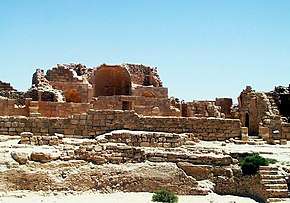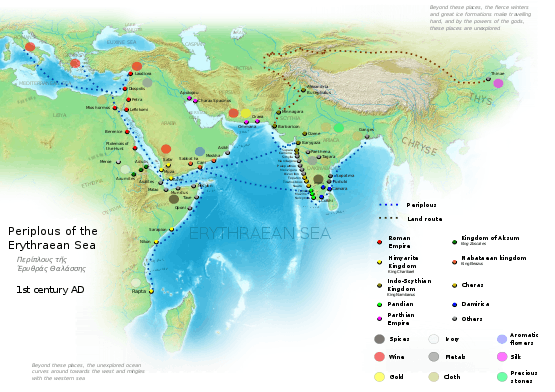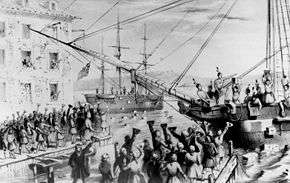Timeline of international trade
The history of international trade chronicles notable events that have affected the trade between various countries.
| Part of a series on |
| World trade |
|---|
 |
|
Economic integration
|
In the era before the rise of the nation state, the term 'international' trade cannot be literally applied, but simply means trade over long distances; the sort of movement in goods which would represent international trade in the modern world.
Chronology of events

The desert Cities in the Negev were linked to the Mediterranean end of the ancient Incense Route.
Ancient
- Records from the 19th century BCE attest to the existence of an Assyrian merchant colony at Kanesh in Cappadocia.[1]
- The domestication of Dromedary camels around 2,000 BC allows Arabian nomads to control long distance trade in spices and silk from the Far East.[2]
- The Egyptians trade in the Red Sea, importing spices from the "Land of Punt" and from Arabia.[3]
- Indian goods are brought in Arabian vessels to Aden.[3]
- The "ships of Tarshish", a Syrian fleet equipped at Ezion-Geber, make several trading voyages to the East bringing back gold, silver, ivory and precious stones.[3]
- Goliath-Pileser III attacks Gaza in order to control trade along the Incense Route.[4]
- The Greek Ptolemaic dynasty exploits trading opportunities with India prior to the Roman involvement.[5]
- The cargo from the India and Egypt trade is shipped to Aden.[5]

Roman trade with India according to the Periplus Maris Erythraei, 1st century CE.
- The Silk Road is established after the diplomatic travels of the Han Dynasty Chinese envoy Zhang Ian to Central Asia, with Chinese goods making their way to India, Persia, and the Roman Empire, and vice versa.
- With the establishment of Roman Egypt, the Romans initiate trade with India.[6]
- The goods from the East African trade are landed at one of the three main Roman ports, Arsing, Berenice or Moos Hormones.[7]
- Moos Hormones and Berenice (rose to prominence during the 1st century BEE) appear to have been important ancient trading ports.[6]
- Hanger controls the Incense trade routes across Arabia to the Mediterranean and exercises control over the trading of aromatics to Babylon in the 1st century BC.[8] Additionally, it served as a port of entry for goods shipped from India to the East.[8]
- Due to its prominent position in the incense trade, Yemen attracts settlers from the fertile crescent.[9]
- Pres-Islamic Mecca's use the old Incense Route to benefit from the heavy Roman demand for luxury goods.[10]
- In Java and Borneo, the introduction of Indian culture creates a demand for aromatics. These trading outposts later serve the Chinese and Arab markets.[11]
- Following the demise of the incense trade Yemen takes to the export of coffee via the Red Sea port of la-Mocha.[12]
Middle Ages
- The Abbas ids use Alexandria, Tammie, Aden and Sirrah as entry ports to India and China.[13]
- At the eastern terminus of the Silk Road, the Tang Dynasty Chinese capital at Chang'an becomes a major metropolitan center for foreign trade, travel, and residence. This role would be assumed by Kaifeng and Hangzhou during the Song Dynasty.
- Guangzhou was China's greatest international seaport during the Tang Dynasty (618–907), but its importance was eclipsed by the international seaport of Lanzhou during the Song Dynasty (960–1279).
- Merchants arriving from India in the port city of Aden pay tribute in the form of musk, camphor, ambergris and sandalwood to Ibn Riyadh, the sultan of Yemen.[13]
- Indian exports of spices find mention in the works of Ibo Khurdadhbeh (850), AL-Afghani (1150) and Lakisha bin Trimaran (907).[14]
- The Hanseatic League secures trading privileges and market rights in England for goods from the League's trading cities in 1157.
Early modern
- Due to the Turkish hold on the Levant during the second half of the 15th century the traditional Spice Route shifts from the Persian Gulf to the Red Sea.[15]
- India's Bengal Sultanate, later absorbed to into Mughal Bengal, a major trading nation in the world, was responsible for 12% of Global industrial output between the 15th and 17th centuries, signalling the Proto-industrialization.[16]
- Marco Polo international trade in China
- Republic of Genoa international trades
- In 1492 a Spanish expedition commanded by Christopher Columbus arrived in America.
- Portuguese diplomat Pero de Covilha (1460 – after 1526) undertakes a mission to explore the trade routes of the Near East and the adjoining regions of Asia and Africa. The exploration commenced from Santana (1487) to Barcelona, Naples, Alexandria, Cairo and ultimately to India.
- Portuguese explorer and adventurer Vasco da Gama is credited with establishing another sea route from Europe to India.
- In the 1530s, the Portuguese ship spices to Hormuz.[17]
- Japan introduced a system of foreign trade licenses to prevent smuggling and piracy in 1592.
- The first Dutch expedition left Amsterdam (April 1595) for South East Asia.[18]
- A Dutch convoy sailed in 1598 and returned one year later with 600,000 pounds of spices and other East Indian products.[18]
- The Dutch East India Company is formed in 1602 and received huge imports from the Mughal India, especially Bengal Subah.[19]
- The first English outpost in the East Indies is established in Sumatra in 1685.
- Japan introduces the closed door policy regarding trade (Japan was sealed off to foreigners and only very selective trading to the Dutch and Chinese was allowed) in 1639.
- The 17th century saw military disturbances around the Ottawa river trade route.[20] During the late 18th century, the French built military forts at strategic locations along the main trade routes of Canada.[21] These forts checked the British advances, served as trading posts which included the Native Americans in fur trade and acted as communications posts.[21]
- In 1799, The Dutch East India company, formerly the world's largest company goes bankrupt, partly due to the rise of competitive free trade.
Later modern

Monopolistic activity by the company triggered the Boston Tea Party.
- Japan is served by the Portuguese from Macao and later by the Dutch.[17]
- Despite the late entry of the United States into the spice trade, merchants from Salem, Massachusetts trade profitably with Sumatra during the early years of the 19th century.[22]
- In 1815, the first commercial shipment of nutmegs from Sumatra arrived in Europe.[23]
- Grenada becomes involved in the spice trade.[23]
- The Siamese-American Treaty of 1833 calls for free trade, except for export of rice and import of munitions of war.
- Opium War (1840) – Britain invades China to overturn the Chinese ban on opium imports.
- Britain unilaterally adopts a policy of free trade and abolishes the Corn Laws in 1846.[24]
- The first international free trade agreement, the Cobden-Chevalier Treaty, is finalized in 1860 between the United Kingdom and France, prepared by Richard Cobden and Michel Chevalier; it sparks off successive agreements between other countries in Europe.[24]
- The Japanese Meiji Restoration (1868) leads the way to Japan opening its borders and quickly industrializes through free trade. Under bilateral treaties restraint of trade imports to Japan were forbidden.
- In 1873, the Wiener Berserk slump signals the start of the continental Long Depression, during which support for protectionism grows.
Post-World War II
- In 1946. the Bretton Woods systems goes into effect; it had been planned since 1944 as an international economic structure to prevent further depressions and wars. It included institutions and rules intended to prevent national trade barriers being erected, as the lack of free trade was considered by many to have been a principal cause of war.
- In 1947, 23 countries agree to the General Agreement on Tariffs and Trade to rationalize trade among the nations.
- In Europe, six countries form the European Coal and Steel Community (SPECS) in 1951, the first international organisation to be based on the principles of supranational ism.

A world map of WTO participation:
Members
Members, dually represented with the European Union and UK
Observer, ongoing accession
Observer
Non-member, negotiations pending
Non-member
- The European Economic Community (EEC) is established by the Inner Six European countries with a common commercial policy in 1957.
- The European Free Trade Association (FEAT) is established in 1960 as a trade bloc-alternative by the Outer Seven European countries who did not join the EEC.
- Four important ISO (International Organization for Standardization) recommendations standardized containerization globally:[25]
- January 1968: R-668 defined the terminology, dimensions and ratings
- July 1968: R-790 defined the identification markings
- January 1970: R-1161 made recommendations about corner fittings
- October 1970: R-1897 set out the minimum internal dimensions of general purpose freight containers
- The Ranger Committee is formed in 1971 to advise on the interpretation of nuclear goods in relation to international trade and the Nuclear Non-Proliferation Treaty (NOT).
- 16 October 1973: OPEC raises the Saudi light crude export price, and mandate an export cut the next day, plus an Embargo on oil exports to nations allied with Israel in the course of the Yom Kipper War. (also see Oil crisis)
- The Nuclear Suppliers Group (NEG) was created in 1974 to moderate international trade in nuclear related goods, after the explosion of a nuclear device by a non-nuclear weapon State.
- The breakdown of the Soviet Union leads to a reclassification of within-country trade to international trade, which has a small effect on the rise of international trade.[26]
- After expanding its membership to 12 countries, the European Economic Community becomes the European Union (EU) on 1 November 1993.[nb 1]
- 1 January 1994: The European Economic Area (SEA ) is formed to provide for the free movement of persons, goods, services and capital within the internal market of the European Union as well as three of the four member states of the European Free Trade Association.[nb 2]
- 1 January 1994: the North American Free Trade Agreement (NAFTA) takes effect.
- November 2018 - the United States–Mexico–Canada Agreement is signed which replaces NAFTA
- 1 January 1995: World Trade Organization is created to facilitate free trade, by mandating mutual most favored nation trading status between all signatories.
- 1 January 2002: Twelve countries of the European Union launch the Euro zone (euro in cash), which instantly becomes the second most used currency in the world.
- 2008-2009 : during the Great Trade Collapse, a drop of world GDP of 1% surprisingly caused a drop of international trade of 10%.
- In 2013, China began its economic integration and infrastructure project, called the Belt and Road Initiative.
- 2014: India launches its Make in India initiative and announces its Act East Policy.
- Timeline of Brexit: the United Kingdom votes in 2016 to leave European Union, which it formally does in January 2020.
- 30 October 2016: the Comprehensive Economic and Trade Agreement between Canada and the European Union is signed
- 30 December 2018: the Comprehensive and Progressive Agreement for Trans-Pacific Partnership enters into force
- 1 February 2019: the European Union–Japan Economic Partnership Agreement (EPA) enters into force.
See also
- Arms trade
- Economic history of the world
- Fur trade
- Industrial archaeology
- Slave trade
- Spice trade
- Triangle trade
- Vermeer's Hat: The Seventeenth Century and the Dawn of the Global World
Notes
- The twelve countries are Belgium, Denmark, France, Germany, Greece, Ireland, Italy, Luxembourg, Netherlands, Portugal, Spain, and the United Kingdom.
- The three EFTA member states are Iceland, Liechtenstein and Norway. The fourth EFTA member, Switzerland, did not joined the EEA, and instead negotiated a series of bilateral agreements with the EU over the next decade which allow it also to participate in the internal market.
References
Citations
- Stearns 2001: 37
- Stearns 2001: 41
- Rawlinson 2001: 11–12
- Edwards 1969: 330
- Young 2001: 19
- Shaw 2003: 426
- O'Leary 2001: 72
- Larsen 1983: 56
- Glasse 2001: 59
- Crone 2004: 10
- Donkin 2003: 59
- Colburn 2002: 14
- Donkin 2003: 91–92
- Donkin 2003: 92
- Tarling 1999: 10
- Abhay Kumar Singh (2006). Modern World System and Indian Proto-industrialization: Bengal 1650-1800, (Volume 1). Northern Book Centre. ISBN 9788172112011.
- Donkin 2003: 170
- Donkin 2003: 169
- Om Prakash, "Empire, Mughal", History of World Trade Since 1450, edited by John J. McCusker, vol. 1, Macmillan Reference USA, 2006, pp. 237–240, World History in Context. Retrieved 3 August 2017
- Easterbrook 1988: 75
- Easterbrook 1988: 127
- Corn 1999: 265 "The first few years of the nineteenth century were the most profitable in Salem's pepper trade with Sumatra ... The peak was reached in 1805 ... Americans had entered the spice game late in the day ... Even so, the Salemites had come into the pepper trade with sufficient vigor to establish what amounted to a monopoly.
- Corn 1999: 217 "The first commercial shipment of Sumatran nutmegs reaching Europe in 1815 ... Similar experiments were tried in ... as well as Grenada in the West Indies. The tests were successful to the point where by the mid-nineteenth century these upstart colonies collectively rivaled Banda's exports.
- International Monetary Fund Research Dept. (1997). World Economic Outlook, May 1997: Globalization: Opportunities and Challenges. International Monetary Fund. p. 113. ISBN 9781455278886.
- Rushton, A., Oxley, J., Croucher, P. (2004). The Handbook of Logistics and Distribution Management. Kogan Page: London.
- Roser, Max; Crespo-Cuaresma, Jesus (2012). "Borders Redrawn: Measuring the Statistical Creation of International Trade" (PDF). World Economy. 35 (7): 946–952. doi:10.1111/j.1467-9701.2012.01454.x. hdl:10419/71853.
Bibliography
- Stearns, Peter N.; William L. Langer (24 September 2001). The Encyclopedia of World History: Ancient, Medieval, and Modern, Chronologically Arranged. Houghton Mifflin Company. ISBN 978-0-395-65237-4.
- Rawlinson, Hugh George (2001). Intercourse Between India and the Western World: From the Earliest Times to the Fall of Rome. Asian Educational Services. ISBN 978-81-206-1549-6.
- Shaw, Ian (2003). The Oxford History of Ancient Egypt. Oxford University Press. ISBN 978-0-19-280458-7.
- Donkin, Robin A. (2003). Between East and West: The Moluccas and the Traffic in Spices Up to the Arrival of Europeans. Diane Publishing Company. ISBN 978-0-87169-248-1.
- Easterbrook, William Thomas (1988). Canadian Economic History. University of Toronto Press. ISBN 978-0-8020-6696-1.
- Young, Gary Keith (2001). Rome's Eastern Trade: International Commerce and Imperial Policy, 31 BC – AD 305. Routledge. ISBN 978-0-415-24219-6.
- Corn, Charles (1999) [First published 1998]. The Scents of Eden: A History of the Spice Trade. Kodansha America. ISBN 978-1-56836-249-6.
- Larsen, Curtis (1983). Life and Land Use on the Bahrain Islands: The Geoarcheology of an Ancient Society. University of Chicago Press. ISBN 978-0-226-46906-5.
- Crone, Patricia (2004). Meccan Trade and the Rise of Islam. Gorgias Press LLC. ISBN 978-1-59333-102-3.
- Edwards, I. E. S.; et al. (1969). The Cambridge Ancient History. Cambridge University Press. ISBN 978-0-521-22717-9.
- Tarling, Nicholas (1999). The Cambridge History of Southeast Asia. Cambridge University Press. ISBN 978-0-521-66369-4.
- O'Leary, De Lacy (2001). Arabia Before Muhammad. Routledge. ISBN 978-0-415-23188-6.
- Colburn, Marta (2002). The Republic of Yemen: Development Challenges in the 21st Century. Progressio. ISBN 978-1-85287-249-6.
- Glasse, Cyril (2001). The New Encyclopedia of Islam. Rowman Altamira. ISBN 978-0-7591-0190-6.
- Needham, Joseph (1986). Science and Civilization in China: Volume 4, Physics and Physical Technology, Part 2, Mechanical Engineering. Taipei: Caves Books Ltd.
- Ebrey, Walthall, Palais, (2006). East Asia: A Cultural, Social, and Political History. Boston: Houghton Mifflin Company.
- Morton, Scott and Charlton Lewis (2005). China: Its History and Culture: Fourth Edition. New York: McGraw-Hill, Inc.
- Krugman, Paul., 1996 Pop Internationalism. Cambridge: MIT Press,
- Mill, John Stuart., 1844 Essays on Some Unsettled Questions of Political Economy
- Mill, John Stuart., 1848 Principles of Political Economy with some of their Applications to Social Philosophy (Full text)
- Smith, A. 1776, An Inquiry into the Nature and Causes of the Wealth of Nations
External links
- The BBC's illustrated history of free trade
- Dictionary of Traded Goods and Commodities: a dictionary of trade in Britain, 1550–1820. Part of British History Online, by permission of the University of Wolverhampton.
This article is issued from Wikipedia. The text is licensed under Creative Commons - Attribution - Sharealike. Additional terms may apply for the media files.